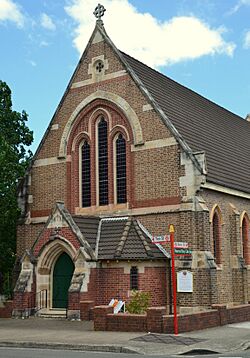St John's Uniting Church, Neutral Bay facts for kids
Quick facts for kids St John's Uniting Church |
|
|---|---|

The exterior of St John's Uniting Church, in 2012
|
|
| 33°49′57″S 151°13′17″E / 33.8325°S 151.2213°E | |
| Location | 49 Yeo Street, Neutral Bay, North Sydney Council, New South Wales |
| Country | Australia |
| Denomination | Uniting (since 1977) |
| Previous denomination | Presbyterian (1980 – 1977) |
| History | |
| Former name(s) | St John's Presbyterian Church |
| Status | Church |
| Founded | 26 April 1890 |
| Dedication | 19 July 1890 |
| Architecture | |
| Functional status | Active |
| Architect(s) | Charles H. Slayter |
| Architectural type | Church |
| Style | Victorian Free Gothic |
| Specifications | |
| Materials | Brick; slate roof, replaced by concrete tiles |
| Administration | |
| Synod | New South Wales and ACT |
St John's Uniting Church and Pipe Organ is a special old church in Neutral Bay, Australia. It's part of the Uniting Church in Australia. The church building was constructed by Tafield and Collins. Inside, there's a very important pipe organ built by Charles Richardson. This church is also known as St. John's Uniting Church and Pipe Organ, or the Richardson Pipe Organ. It is owned by the Uniting Church of Australia. Because of its history and unique features, it was added to the New South Wales State Heritage Register on April 2, 1999.
Contents
History of St John's Church
The story of St John's Church began in 1889. At that time, a group of Presbyterian people in Neutral Bay wanted to build a church. A generous person named Captain Robert Craig donated the land for the church.
Building the Church
The first stone for the church was laid on April 26, 1890. The church was designed by an architect named Charles H. Slatyer. It was built by a company called Messrs Tafield and Collins. The church officially opened its doors on July 19, 1890.
When it first opened, the church looked simpler than it does today. It was later made bigger in 1898 and again in 1908. The important pipe organ was put in the church in 1912. A house for the minister, called a manse, was built in 1920. A school hall was added in 1923. In 1977, the church became part of the Uniting Church in Australia.
What the Church Looks Like
St John's Church is made of brick with stone details. It has a steep roof with gables. Inside, the walls are plastered. Each section of the church has a special memorial tablet. There is a beautifully carved pulpit. The church also has two unique windows in the organ area. These windows were designed by Norman St Carter and made by F. J. Tarrant. The roof inside is made of wooden beams that form arches.
The Pipe Organ
The pipe organ in the church was installed in 1912. It is a very rare and complete example of the work of Charles Richardson. He was a famous organ-maker in New South Wales from 1883 to 1920. The organ's design is special for its time. It also uses an older type of mechanism called "tracker action" for its keys.
Changes Over Time
The church's original roof was made of slate. In 1979, this slate roof was replaced with concrete tiles. A part of the church on the north side was added later. This addition has a large window with three sections and a nice stone entrance porch. The area where the organ is, at the south end, was also added later and has its own roof.
Why St John's Church is Important
St John's Uniting Church is considered very important for several reasons. It's a great example of the Victorian Free Gothic style of architecture from the late 1800s. This style was adapted to fit the needs of the Presbyterian church. The church's location on a corner makes it a noticeable and important building in the area.
The way the roof is built, using thin layers of wood to create circular arches, is very unique for its age. The pipe organ is also very significant. It's a rare and complete example of the work of Charles Richardson, who was a leading organ builder in New South Wales for many years. The detailed woodwork inside the church is also very special.
Because of all these important features, St John's Uniting Church and Pipe Organ was officially listed on the New South Wales State Heritage Register on April 2, 1999. This means it is protected as a valuable part of history.
See also
- Uniting Church in Australia

